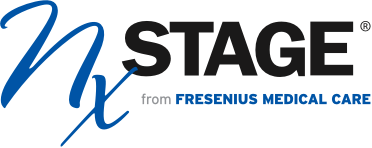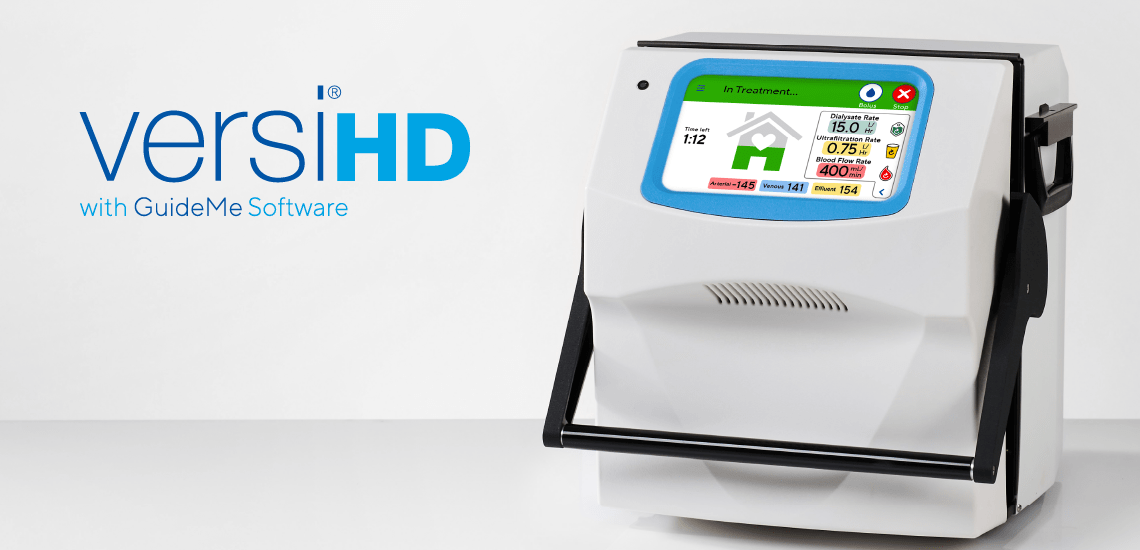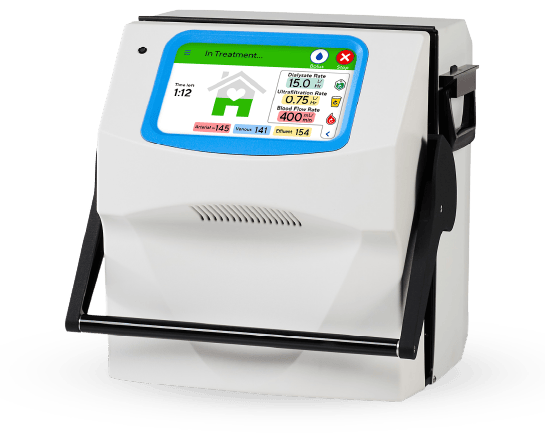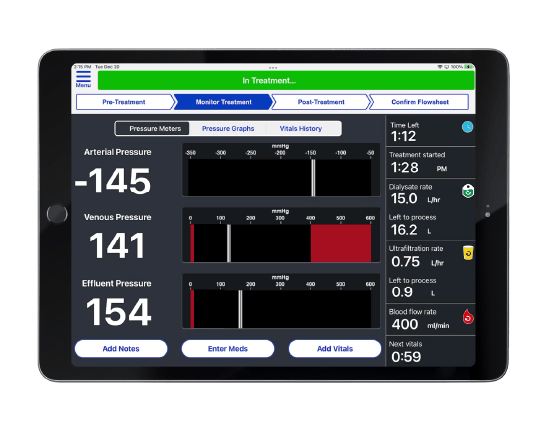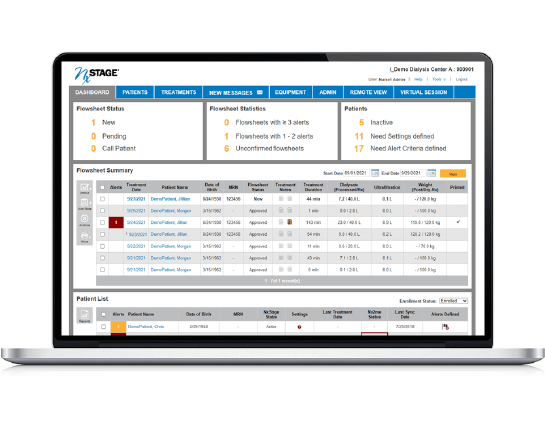NxStage Versi®HD with GuideMe Software
We offer a flexible and dependable home hemodialysis (HHD) therapy experience and provide clinicians with the right tools and support to enable efficient remote patient management.1
GuideMe Software
Through advances in user interface design, GuideMe Software aims to improve ease of learning, training retention, and overall usability for both patient and care partner.
Ease of Use
Ease of use extends to the steps to begin a treatment: Insert a single-use cartridge into the cycler, spike a bag of saline, and press the start priming button on the touch screen. Pressing the ‘Guide Me’ button displays step-by-step illustrated instructions to assist in a particular task.
Portable
Pre-mixed bags give patients the ability to treat almost anywhere their destination takes them.
Emergency-Ready
Dialyze anywhere — even when electricity or a water source is not readily available. The system can be run using a generator and/or with disposable pre-mixed bags.
Take a Tour of VersiHD with GuideMe Software
In this short video, learn about the features and functionality of the VersiHD cycler.
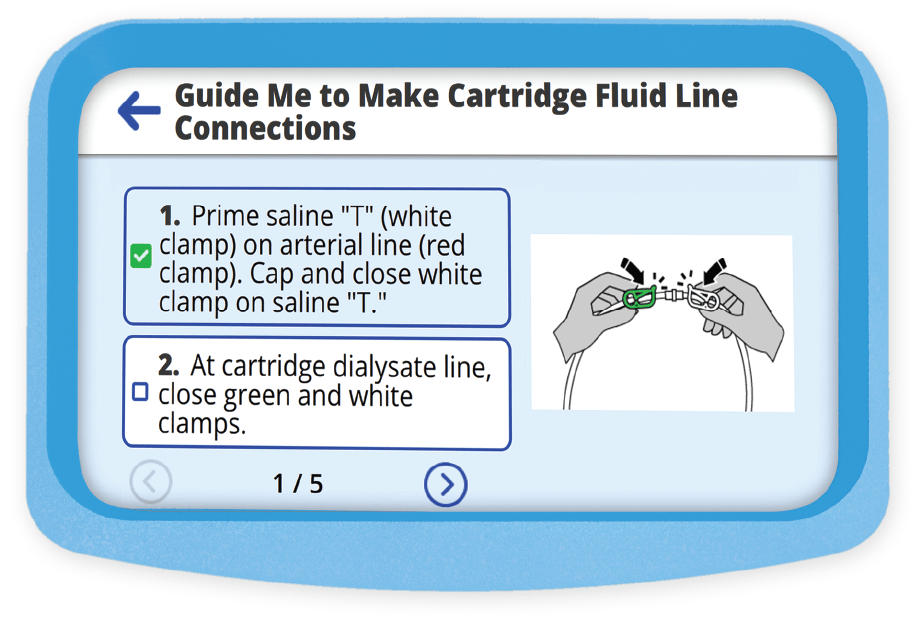
GuideMe Software
Features step-by-step, on-screen instructions throughout setup, treatment, and troubleshooting.
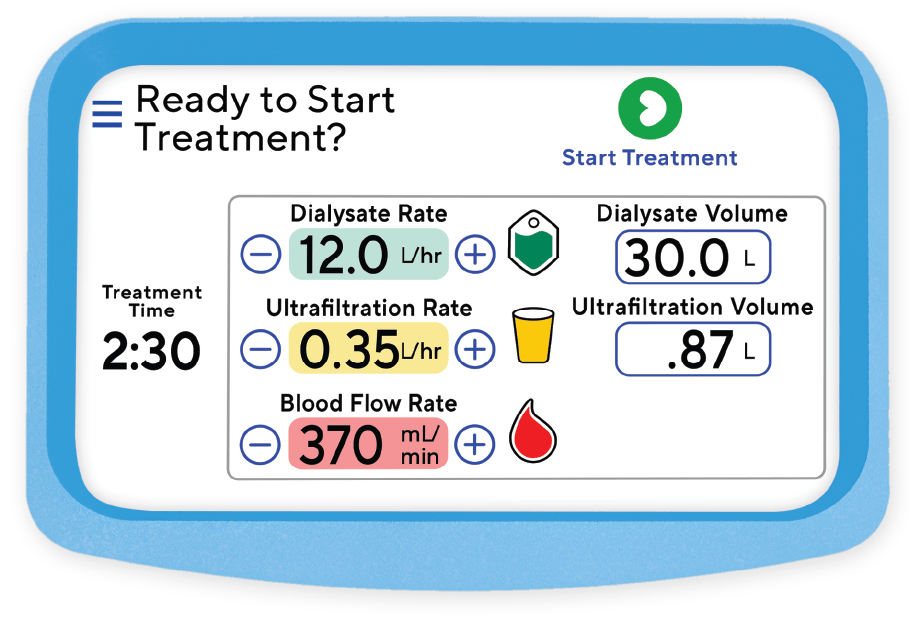
Enhanced Displays
Are designed to consolidate and intuitively summarize pertinent treatment information.
Product Features
Cartridge
- Pre-attached dialyzer reduces the potential risk of touch point contaminations.
- Drop-in sterilized cartridge is a closed system, without a blood-air interface, helping to reduce the need for anticoagulants during treatments.1
- The entire blood flow and dialysate pathways are disposable, so there’s no need for long post-treatment heating or disinfection with dangerous chemicals.
- The cycler can simply be wiped down, and the cartridge thrown away.
VersiHD Screen
- Touchscreen is designed to be intuitive and user-friendly, allowing for responsive key presses and advanced on-screen displays.
PureFlow™ SL
- PureFlow is designed, tested, and validated to produce ultrapure water from tap water, accommodating most home water sources.
- Roughly the size of an end table, it minimizes the need for delivery, storage, and disposal of prefilled bags.
- Unlike conventional water-treatment systems that require plumbing modifications, PureFlow needs only a simple faucet or under-sink hookup while dialysate is prepared.
- And a prepared batch lasts 96 hours — so a patient can do multiple treatments on a single PureFlow batch.1
Dimensions
- VersiHD: 18″ H x 15″ W x 15″ D
- PureFlow SL: 26″ H x 20″ W x 19″ D
Nx2me Connected Health®
- Using the Nx2me app, patients can electronically record their flowsheet information, including blood pressure, pulse, and medications.
- Data is automatically recorded from the cycler, such as rates, volumes, and pressures.
- Once the treatment is complete, the finished flowsheet is securely submitted to the Clinician Portal, so healthcare providers can view, track, and monitor completed treatment data for their patients.
Cartridge
- Pre-attached dialyzer reduces the potential risk of touch point contaminations.
- Drop-in sterilized cartridge is a closed system, without a blood-air interface, helping to reduce the need for anticoagulants during treatments.1
- The entire blood flow and dialysate pathways are disposable, so there’s no need for long post-treatment heating or disinfection with dangerous chemicals.
- The cycler can simply be wiped down, and the cartridge thrown away.
VersiHD Screen
- Touchscreen is designed to be intuitive and user-friendly, allowing for responsive key presses and advanced on-screen displays.
PureFlow™ SL
- PureFlow is designed, tested, and validated to produce ultrapure water from tap water, accommodating most home water sources.
- Roughly the size of an end table, it minimizes the need for delivery, storage, and disposal of prefilled bags.
- Unlike conventional water-treatment systems that require plumbing modifications, PureFlow needs only a simple faucet or under-sink hookup while dialysate is prepared.
- And a prepared batch lasts 96 hours — so a patient can do multiple treatments on a single PureFlow batch.1
Dimensions
- VersiHD: 18″ H x 15″ W x 15″ D
- PureFlow SL: 26″ H x 20″ W x 19″ D
Nx2me Connected Health®
- Using the Nx2me app, patients can electronically record their flowsheet information, including blood pressure, pulse, and medications.
- Data is automatically recorded from the cycler, such as rates, volumes, and pressures.
- Once the treatment is complete, the finished flowsheet is securely submitted to the Clinician Portal, so healthcare providers can view, track, and monitor completed treatment data for their patients.
Pre-Mixed Bags
- Pre-mixed dialysate provides mobility for patients within the home and when they travel.
- This source water flexibility provides critical access to dialysate in the event of a loss of clean source water due to an emergency situation.
VersiHD Screen
- The touchscreen interface allows for responsive key presses and advanced on-screen displays. Buttons also only illuminate when they can be adjusted, enhancing clarity and confidence during treatment, and limiting disruption at night.
Dimensions
- VersiHD: 18″ H x 15″ W x 15″ D
Nx2me Connected Health®
- Using the Nx2me app, patients can electronically record their flowsheet information, including blood pressure, pulse, and medications.
- Data is automatically recorded from the cycler, such as rates, volumes, and pressures.
- Once the treatment is complete, the finished flowsheet is securely submitted to the Clinician Portal, so healthcare providers can view, track, and monitor completed treatment data for their patients.
Fluid Warmer
Pre-Mixed Bags
- Pre-mixed dialysate provides mobility for patients within the home and when they travel.
- This source water flexibility provides critical access to dialysate in the event of a loss of clean source water due to an emergency situation.
VersiHD Screen
- The touchscreen interface allows for responsive key presses and advanced on-screen displays. Buttons also only illuminate when they can be adjusted, enhancing clarity and confidence during treatment, and limiting disruption at night.
Dimensions
- VersiHD: 18″ H x 15″ W x 15″ D
Nx2me Connected Health
- Using the Nx2me app, patients can electronically record their flowsheet information, including blood pressure, pulse, and medications.
- Data is automatically recorded from the cycler, such as rates, volumes, and pressures.
- Once the treatment is complete, the finished flowsheet is securely submitted to the Clinician Portal, so healthcare providers can view, track, and monitor completed treatment data for their patients.
Fluid Warmer
VersiHD & Nx2me Connected Health
References:
- NxStage Medical, Inc. (2020). VersiHD User Guide. Lawrence, MA.
- Data on File. NxStage Medical, Inc. 2023.
Risks and Responsibilities
Patients should review the following information carefully and discuss it with their doctors to decide whether home hemodialysis with NxStage systems is right for them.
- Medical staff will not be present to respond to health emergencies that might happen during home treatments.
- Users and their care partners will be responsible for all aspects of their hemodialysis treatments from start to finish.
- Users may not experience the reported benefits of home, more frequent or nocturnal hemodialysis with the NxStage systems.
- The NxStage systems require a prescription for use.
- If a doctor prescribes more frequent home hemodialysis, vascular access is exposed to more frequent use which may lead to access related complications, including infection of the site. Doctors should evaluate the medical necessity of more frequent treatments and discuss the risks and benefits of more frequent therapy with users.
- If a doctor prescribes “solo/independent” home hemodialysis without a care partner during waking hours, risks of significant injury or death increase because no one is present to help users respond to health emergencies. If users experience needles coming out, blood loss, or very low blood pressure during solo home hemodialysis, they may lose consciousness or become physically unable to correct the health emergency. Users will need additional ancillary devices and training to perform solo home hemodialysis.
- If a doctor prescribes “nocturnal” home hemodialysis at night while the user and a care partner are sleeping, risks increase due to the length of treatment time and because therapy is performed while users and their care partners are sleeping. These risks include, among other things, blood access disconnects and blood loss during sleep, blood clotting due to slower blood flow or increased treatment time or both, and delayed response to alarms when waking from sleep.
